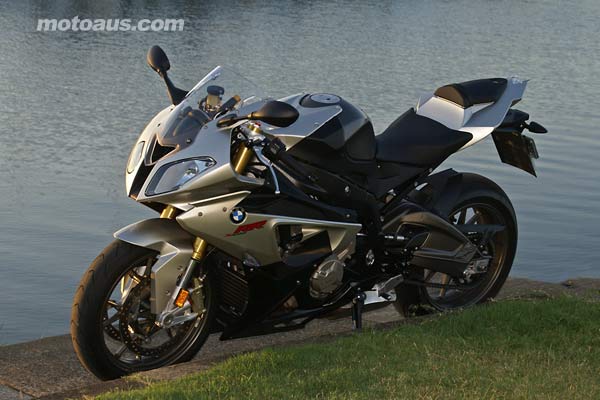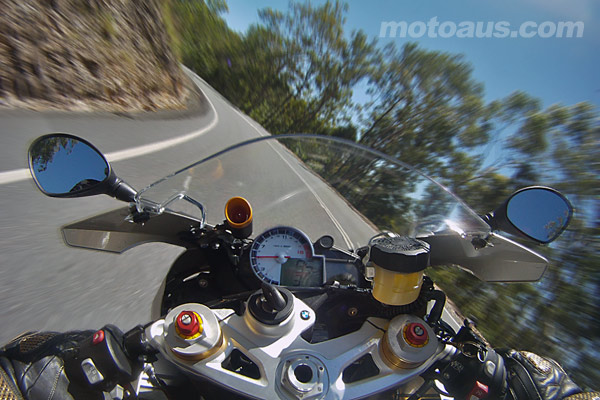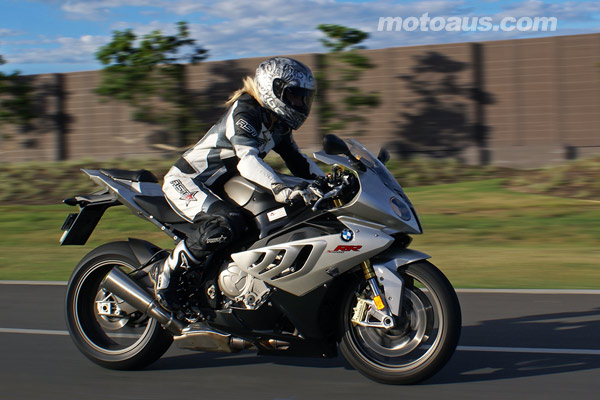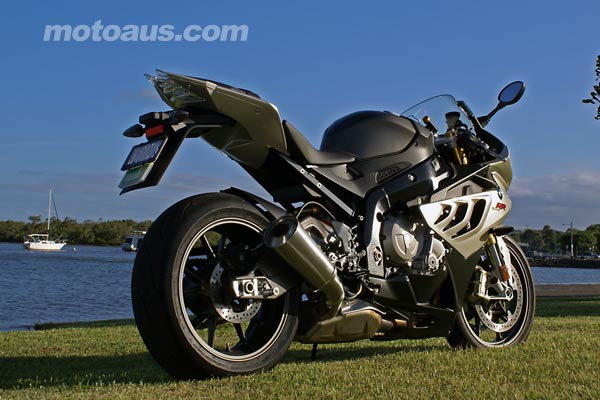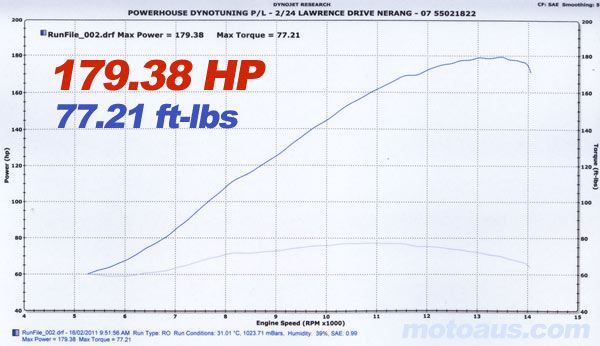
Motoaus takes a ride on BMW’s class leading litre sportsbike, the S1000RR
BMW S1000RR Ride Review
Motorcycle design is a process of evolution. Each year or two, the various super-sport models add a few horsepower, drop a little weight, and get a little more track focused. BMW decided to jump all that and use a bit of creation instead. The S1000RR was designed to be faster, sharper, and more powerful than it’s competitors right from the get go.
After riding the Bavarian beast, we would agree with all of the praises that have been sung about it’s race tested capabilities. On the road, it really is so far beyond what you could ever use in terms of performance, that a “road test” is meaningless. If you are looking to read a glowing report on how the BMW is “faster” and “better” than the GZSR-1, we can’t help you there.
The simple fact is, that with 180 horsepower put out at the rear tyre, and similar weight and size to a 600, you can not use any more than short bursts of full throttle on the road. Anyone telling you otherwise is either a liar, or lives near a racetrack.
In terms of power, brakes and precision handling – for what it’s worth – the BMW thou is the Number One that we have ridden up till now. It also has the added bonus of having perhaps the best and most complex electronics package released on a road going motorcycle.
Sitting on the BMW for the first time you would be excused for thinking you were sitting on any one of the competitors 600 super-sport machines, it really is compact. In fact, swapping back onto a GSX-R1000 made the big Suzuki feel very relaxed and roomy.
That’s not to say the BMW is overly cramped, just very head down, weight on the wrists position. A few kilometres down the road and you will be marveling at the engine – the jewel in the BMW package.
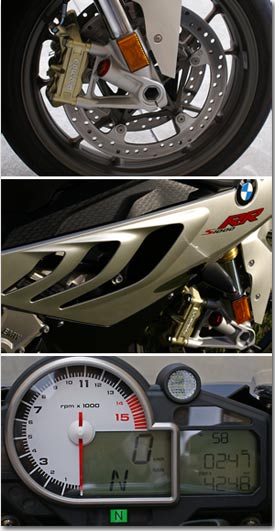 While the dyno run showed the BMW was in fact running a tad rich from the factory, to ride it you can’t help but be in awe of the ride-ability, it literally will pull away from rolling pace in top gear, and wind on smoothly all the way until about 9000 rpm, when things really start to happen.
While the dyno run showed the BMW was in fact running a tad rich from the factory, to ride it you can’t help but be in awe of the ride-ability, it literally will pull away from rolling pace in top gear, and wind on smoothly all the way until about 9000 rpm, when things really start to happen.
Of course you could do this on the street, but a quick run to the upper end of the tacho in the first 3 gears will see you at a couple hundred kilometres per hour, like most big super-sport machines. On the BMW though, it happens just that little bit quicker.
The brakes are extremely powerful, genuine one finger braking at all road speeds is all that’s needed. Riding position is very much head forward and over the front wheel, and as you’d expect, the BMW goes where you point it – easily. We covered some pretty bumpy roads, not really a super-sport machine’s forte, but apart from the firm suspension and seat making for a bumpy ride, the RR didn’t show any kind of head shaking.
Multiple riding modes are now a given on performance bikes, the BMW featuring a 4 mode system – Rain, Sport and Race modes plus an extra “Slick” mode that needs to be activated first. A very easy to use scrolling mode button, and a quick reset via pulling the clutch in, even on the move, made this the nicest of the set-ups we have used.
Rain mode drops a lot of power out with “only” 150 hp available, while Sport is the recommended road setting with full power, but a softer delivery. The Race and Slick modes could be re-tagged “Awesome” and “Crazy” both offering increasing amounts of direct power to the pavement.
The Motor
What sets the BMW motor apart from the competition is found in the basic design. Borrowing from Formula 1 knowledge, BMW have gone for a massive bore size, with 80mm pistons, and a short stroke of only 49.7mm. This compares to GSX-R’s 74.5mm, 76mm on the Kawasaki ZX10-R, and 78mm on the R1.
A larger bore allows for a shorter stroke obviously, which means a potential higher rpm as the piston doesn’t have to travel as far or fast at a given rpm. It also allows more space around larger valves, with improved air flow in the cylinder thanks to what’s known as” unshrouding ” of the valves.
The Formula One connection becomes apparent in the cylinder head, with BMW’s valve train mechanism reportedly 50% lighter than the more conventional style used by other brands. A lighter valve train via a “finger follower” style valve actuator rather than the more typical “cam” on bucket design allows a more radical cam profile without control or wear issues with the titanium valves. 48mm throttle bodies are controlled by a “ride by wire” computer system, and the fuel injection management is another highlight.
The inlet tact is a variable length, which is a key reason the engine is tractable down low in the revs – with the intake lengthened out for torque- while still making a screaming top end as the manifold shortens down. The injectors – two sets of them, with the top four pointed straight down into the top of the throttles, are controlled by pressure as well as duration. The list of technical refinements in this engine could fill a whole page on their own, the bottom line – BMW’s engine package is one step ahead of the competition at this time.
As a benchmark for current 1000cc super-sport race replica motorcycles, the BMWS1000RR is the clear leader at this time. In fact it’s no replica, it is a race bike you can register. It has the worlds smallest pillion seat, the ride is uncompromising, and harsh on aging wrists or backs. A moment of indiscretion on the throttle will see you taking the bus for a few months, and the extremely efficient engine cooling system transfers cylinder temperature directly to your left upper leg at low traffic speeds.
But none of the above will stop those who want this type of motorcycle from buying it. It represents the current pinnacle of road motorcycle performance. You only have to read some road tests from 20 years ago to realise that development is continual and what seems incredible today, may be normal tomorrow.
The BMWS1000RR does represent a point at which it is hard to imagine you could get -or need – any more performance from a road going motorcycle.
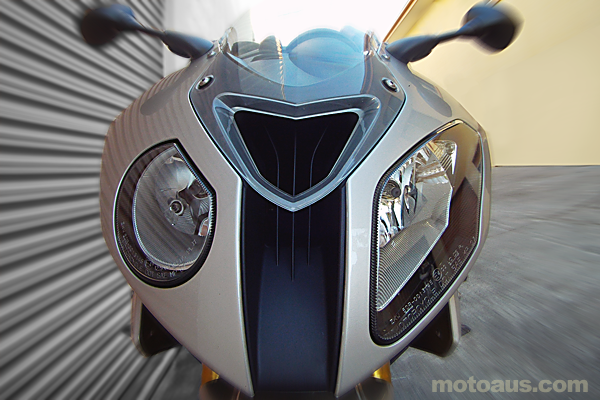
******
BMW doesn’t see fit to provide us with test bikes at this point – this particular bike was not a press bike. Owned by \Australian Champion drag racer Dave “Robot” Rundmann, the big BMW had found it’s way to us after a dyno session at Gold Coast based Powerhouse Dyno Tuning. Dave wanted a few extra kilometres put on the RR to loosen things up a bit, and we were happy to oblige. As we picked up the bike we took a look at the the dyno results. Obviously BMW haven’t been telling any porkies about the power, the stock 1000RR was putting down a healthy 179 horsepower to the dyno rollers at the rear tyre. (see graph)
To put the power of the BMW into perspective, owner Dave won the 2009 ANDRA Australian Competition Bike championship on his 2006 GSX-R1000. With modified engine, and lowered for drag strip launching, Dave’s championship winning run was a 9.43 second effort. At a recent drag test session his new BMW, with no modifications apart from 1 tooth off the front sprocket, the standard height BMW has run 9.75 seconds over the quarter, only a few tenths of a second slower. Amazing!
BMW S1000RR Specifications
Engine
Capacity: 999cc
Bore/stroke: 80.0/49.7mm
Max output kW/hp: 142/193 at 13,000 rpm
Max torque: 112/83 Nm/lb-ft At 9750 rpm
Compression ratio/fuel grade 13:1/ min premium unleaded (95 RON)
Valves per cylinder 4
Intake/exhaust dia 33.5/27.2mm
Throttle butterfly dia 48mm
Electrical System
Alternator W 434
Battery V/Ah 14/10 or 12, maintenance-free
Headlight W Low beam 1x H 7/55 W
High beam 1x H 7/55 W
Starter kW 0.8
Transmission
Clutch Multi-disc anti-hopping oil bath clutch, operated mechanically
Gearbox Six-speed gearbox, dog-type shift
Primary transmission ratio 1:1.652
Gear ratios I 1:2.6471
II 1:2.091
III 1:1.727
IV 1:1.500
V 1:1.360
VI 1:1.261
Final drive ratio 1:2.588
Suspension
Frame Bridge frame, aluminium
Front USD fork, fixed tube dia 46 mm
Rear Double swing arm with central spring strut in spring base, adjustable
Travel front/rear 120/130mm
Castor 95.9mm
Wheelbase 1432mm
Steering head angle ° 66.1
Brakes
Front Double disc brake 320 mm
Radial 4-piston fixed callipers
Rear Single disc brake, dia 220 mm, single-piston floating calliper
ABS Optional: BMW Motorrad Race ABS
(partly integral, on-demand)
Wheels
Cast aluminium
front 3.50 x 17″
rear 6.00 x 17″
Tyres front 120/70 ZR 17
rear 190/55 ZR 17
Dimensions and Weight
Length, overall 2,056mm
Width, overall, with mirrors 826mm
Seat height 820mm
Weight, unladen, with full tank 204kg (206.5 with ABS)
Tank capacity 17.5 litres

